O.Thetford, P.Gray German Aircraft of the First World War (Putnam)
Gotha G VII (prototype)
During 1918, Gotha developed the twin-engined machine into a smaller, lighter aircraft intended mainly for ultra-long-range photo-reconnaissance duty. Later in the year special units were formed, Reihenbihlzug (Photographic Section), whose establishment consisted of four aircraft. See Gotha G VII (Production) for continuation.
Gotha G VII (production)
As may be seen, the production aircraft bore little resemblance to the prototype G VII. Additional interplane struts were added; there were ailerons at all four wingtips with improved balances; a compound tail nit was incorporated and the wings were slightly swept to compensate the "sawn-off" nose. With the accent on speed, forward armament was deleted, and the consequent shortened nose enabled the engines to be placed closer together, thereby improving asymmetric power characteristics. Engines, two 260 h.p. Mercedes D IVa. Span, 19.27 m. (63 ft. 2 3/4 in.), length. 9.63 m. (31 ft. 7 1/8 in.). Area, 63.8 sq.m. (689 sq.ft.). Weights: Empty, 2,419 kg. (5,322 lb.). Loaded, 3,139 kg. (6,906 lb.). Speed, 180 km.hr. (112.3 m.p.h.). Climb. 6,000 m. (19,680 ft.) in 38 min. Duration. 3 hr. Armament, one Parabellum machine-gun in dorsal position.
Gotha G VIII
Further development of the short-nose twins resulted in the G VIII, which may be seen to resemble the prototype G VII except for the wings of noticeably increased span. A lightened version, designated GL VIII, had a compound tail assembly and auxiliary struts bracing the upper wingtips. Engines, two 245 h.p. Maybach Mb IV. Span, 21.73 m. (71 ft. 3 5/8 in.). Length, 9.79 m. (32 ft. 1 1/2 in.). Height, 3.51 m. (11 ft. 6 1/4 in.). Area, 79 sq.m. (861 sq.ft.). Weights: Empty, 2,676 kg. (5,887 lb.). Loaded, 3,706 kg. (8,153 lb.). Speed, 180 km.hr. (112.5 m.p.h.).
J.Herris Gotha Aircraft of WWI (A Centennial Perspective on Great War Airplanes 6)
Gotha G.VII/GL.VII
Ordered on 15 March 1917, before daylight operations by Gotha G.LV aircraft had begun over the UK, four prototypes were built. These were designated Gs.I by Gotha and G.VII and G.VIII by Idflieg. The first prototype, Gotha GL.VII 550/17, was completed in September 1917, the month that Kagohl 3 transitioned to night bombing of the UK due to strengthened British defenses and increasing losses of Gotha G.IV bombers on daylight missions.
The single-bay Gotha GL.VII 550/17, powered by two 260 hp Mercedes D.IVa engines, was one of four prototypes (G.550-553/17) ordered at the same time to explore different engine and wing configurations to determine the optimum layout to meet the demanding Idflieg requirements. A characteristic of the design was the close spacing of the engines to minimize asymmetric thrust with one engine out. This configuration was based on a patent by Ingenieur Michael Schlieffer, a Gotha pilot, and used the venturi effect between the nacelle and fuselage to minimize drag and help counter asymmetric thrust. The close engine spacing required a short nose that precluded a forward gunner.
The next prototype, Gotha G.VII 551/17, had a longer, two-bay wing cellule. The Gotha G.VII was faster than the Albatros D.III but, despite months of intensive testing to optimize engine, airframe, and propeller configurations to maximize speed, climb, and ceiling, the desired performance was not achieved. In late 1918 engines with experimental centrifugal superchargers were installed in this machine for testing.
The production standard GL.VII had a two- bay wing cellule with aerodynamically balanced ailerons on the upper wing and a box (biplane) tail. In 1918 eight aircraft were produced from an order for 55 aircraft (G.300-354/18). Gotha GL.VII 300/18 was the first of these and was powered by two Maybach Mb.IVa engines. It was sent to the front for evaluation in May 1918. GL.VII 302/18 went to the front on 27 June, followed by 301/18 on 1 August and 304/18 on 26 October. However, no further information is available on the evaluation of these aircraft and it is not known if they flew any operational sorties.
Owing to promising results obtained in early Gotha tests, both Aviatik and LVG were awarded contracts in February 1918 to build the Gotha G.VII under license. Aviatik built 30 G.VII aircraft (G.100-129/18), few of which were handed over to the Allies after the war. Aviatik-built Gotha G.VII(Av) 112/18 was experimentally fitted with nose radiators for flight trials.
Gotha G.VII/GL.VII Specifications
Engines: 2 x 260 hp Mercedes D.IVa
Wing: Span 19.27 m
General: Length 9.60 m
Empty Weight 2420 kg
Loaded Weight 3140 kg
Maximum Speed: 180 km/h
Service Ceiling: 6000 m
Gotha G.VIII/GL.VIII
Intended for high-speed day bombing, the Gotha GL.VII was fitted with an enlarged, three-bay wing to improve climb and ceiling. One fixed, forward-firing machine gun was fitted for the pilot, and the gunner had both dorsal and ventral flexible guns for defense.
The Gotha GL.VIII prototype, G.VIII 552/17, was powered by Mercedes D.IVa engines, but the production standard was the over-compressed 260 hp Maybach Mb.IVa for more power at high altitude. All control surfaces were aerodynamically balanced and the biplane tail was retained for improved control with one engine out. The PuW bombs were carried externally under the fuselage.
Gotha GL.VIII 307/18, powered by two 260 hp Maybach Mb.IVa engines, was sent to the Doberitz test center on 19 October 1918. The upper ailerons were fitted with Flettner servo controls for lighter control forces. According to an Idflieg appreciation, the performance of these aircraft "lagged far behind expectations." On the other hand, the war ended before sufficient experience was gathered to evaluate the aircraft adequately under combat conditions.
Gotha G.VIII/GL.VIII Specifications
Engines: 2 x 260 hp Maybach Mb.IVa
Wing: Span 21.73 m
Chord 2.05 m
Gap 2.00 m
General: Length 9.79 m
Useful Load 1030 kg
Loaded Weight 3706 kg
Maximum Speed: 180 km/h
Service Ceiling: 6000 m
Gotha GL-Type Production Summary
Manufacturer Type Qty Serials Notes
Gotha G.VII & G.VIII 4 550/17-553/17 Prototypes,- all 4 completed.
Gotha G.VII & G.VIII 55 300/18-354/18 Production aircraft; only 8 were completed.
Aviatik G.VII(Av) 100 100/18- 129/18* At least 30 completed.
LVG G.VII( LVG) 30 200/18-229/18 Reconnaissance aircraft. All 30 believed to have been completed.
Notes: *Rest of serials unknown.
P.Grosz, G.Haddow, P.Shiemer Austro-Hungarian Army Aircraft of World War One
Gotha G.V and G.VII
Idflieg offered the LFT five surplus Gotha G.V and 30 Gotha G.VII twin-engined bombers, less engines, as dual-control trainers in August 1918. Perhaps unknown to the LFT was the fact that, after much experimentation, the Gotha G.VII bomber proved a disappointing failure because it was unable to reach the specified operational altitude of 6000 meters (19,685 ft). This made it unsuitable for the day bomber and long-range reconnaissance role for which it had been designed. Uzelac declined the offer on grounds of "the poor service record experienced with the 40 Gotha G.IV(LVG) bombers in spite of having reinforced the airframe."
Журнал Flight
Flight, September 11, 1919.
AVIATIK "MILESTONES"
In addition to their single-seaters and two-seaters, the Aviatik firm have also built several large machines (Riesenflugzeug), illustrations of three of which are published herewith.
The Aviatik, Type Go. G VII
built in 1918, is a twin-engined machine of the bomber type. It was fitted with two 200 h.p. Benz engines placed on the wings in short engine nacelles. The radiators were in the nose of these nacelles. From the photograph it will be noticed that the two engine nacelles are placed comparatively close to the main fuselage, the nose of which is very short, allowing the tractor airscrew blades to pass in front of it. This arrangement of the engines has brought about a somewhat unusual strutting arrangement, as regards the inner cellule, at any rate. The tail is of the biplane type, with three rudders.
 |
J.Herris - Gotha Aircraft of WWI /Centennial Perspective/ (6)
|
| Gotha GL.VII 300/18
|
 |
J.Herris - Gotha Aircraft of WWI /Centennial Perspective/ (6)
|
| Gotha GL.VIII 307/18
|
 |
J.Herris - Gotha Aircraft of WWI /Centennial Perspective/ (6)
|
| The prototype of a Gotha GL-type was the single-bay G.VII G.550/17, shown in September 1917. The engines rotated in opposite directions to minimize torque and the wheels are faired to reduce drag. However, the fuselage is suspended between the wings by a complex set of drag-producing struts.
|
 |
J.Herris - Gotha Aircraft of WWI /Centennial Perspective/ (6)
|
Gotha G.VII G.550/17 shown in September-October 1917 with wheel fairings removed for flight tests.
The Gotha GL.VII was an attempt to produce a fast day bomber and long-range reconnaissance plane. Prolonged development of the basic configuration was needed to achieve satisfactory speed and ceiling, with the result that none reached the front in time for combat.
|
 |
J.Herris - Gotha Aircraft of WWI /Centennial Perspective/ (6)
|
| Gotha G.VII G.550/17 as built was very compact for a twin-engine aircraft.
|
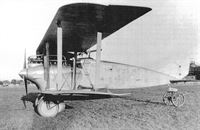 |
J.Herris - Gotha Aircraft of WWI /Centennial Perspective/ (6)
|
| A Gotha GL-prototype, probably G.VII G.550/17 due to its wheel fairings, displays its very clean lines. Early GL-types had a single fin and rudder.
|
 |
J.Herris - Gotha Aircraft of WWI /Centennial Perspective/ (6)
|
| One of the Gotha GL-prototypes, still with a single fin and rudder, now has the fuselage faired into the lower wings to reduce drag.
|
 |
J.Herris - Gotha Aircraft of WWI /Centennial Perspective/ (6)
|
| This Gotha GL-prototype may be the same aircraft as the one at the previous photo, but the propeller spinners have been removed.
|
 |
J.Herris - Gotha Aircraft of WWI /Centennial Perspective/ (6)
|
| A Gotha GL.VII G.300/18 represents the production version of the aircraft. Now it has a 'box' tail for better directional control with one engine out, no wheel fairings, and no propeller spinners.The wings are now longer, with two-bays of struts, and the aileron aerodynamic balances have slots in them.
|
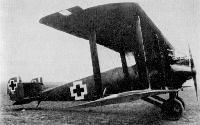 |
O.Thetford, P.Gray - German Aircraft of the First World War /Putnam/
|
| Gotha G VII (production)
|
 |
J.Herris - Gotha Aircraft of WWI /Centennial Perspective/ (6)
|
A rear quarter view of Gotha GL.VII G.300/18, the production version of the GL.VII. The 'box' tail is visible and the rudders, like the ailerons, have aerodynamic balances with slots in them.
Too late to take an active part in combat, the 3-man Gotha G VII bomber/long range reconnaissance type of mid-1918 had a top level speed of 112mph thanks to its twin 260hp Maybach Mb IVa engines. The G VII's operational ceiling was 19,685 feet, while the range, with bomb load, of 335 miles was clearly capable of significant extension for photo-reconnaissance work. Plans had been put underway to build this type in quantity, with contracts placed with Gotha for 55, plus a further 100 from Aviatik in Leipzig. As it was, only 11 had been completed at the time of the Armistice, three of which found their way into Soviet hands.
|
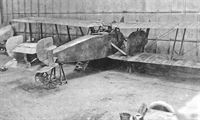 |
J.Herris - Gotha Aircraft of WWI /Centennial Perspective/ (6)
|
| This Gotha GL.VII in the factory has no markings, but the wings are covered in regular camouflage fabric with hexagons. The fuselage has been spray-painted in hexagons with soft edges. This may be one of the GL-prototypes.The 'box' tail has the more common aerodynamic balances without slots in them.
|
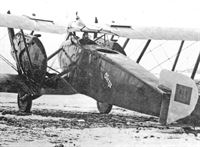 |
J.Herris - Gotha Aircraft of WWI /Centennial Perspective/ (6)
|
| Post-war Ukrainian Gotha GL.VII Olena made an emergency landing at Vajnory airfield near Bratislava, Czechoslovakia, in early 1920. Despite the fact that Ukrainian aircraft had been over-flying Czechoslovakia with permission since 1919, Czechoslovakian authorities interned Olena. After repairs Olena was flown to Prague for evaluation in February or March.The German pilot flew the aircraft, but he had two Czech mechanics with him.
|
 |
J.Herris - Gotha Aircraft of WWI /Centennial Perspective/ (6)
|
|
|
 |
J.Herris - Gotha Aircraft of WWI /Centennial Perspective/ (6)
|
| Postwar lineup of a Gotha GL.VII (at left), an AEG (center), and a Friedrichshafen (at right) at Bickendorf. The GL.VII has a fuselage band over the cross insignia, its location indicating it was built by Aviatik.
|
 |
J.Herris - AEG Aircraft of WWI /Centennial Perspective/ (16)
|
| An AEG G.IV rests on an airfield with a Gotha GL.VII (left) at Bickendorf postwar.
|
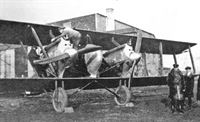 |
J.Herris - Gotha Aircraft of WWI /Centennial Perspective/ (6)
|
| This Gotha GL.VII has an aluminum nose and propeller spinners. The radiators were mounted in the upper wing above the engines, the position used for production aircraft.
|
 |
Jane's All The World Aircraft 1919 /Jane's/
|
| An Aviatik Twin-engined Biplane, Type G1. (2-230 h.p. Benz engines.) (???)
|
 |
J.Herris - Gotha Aircraft of WWI /Centennial Perspective/ (6)
|
| This Gotha GL.VII may have been photographed in Czechoslovakia, but details are unknown.
|
 |
J.Herris - Gotha Aircraft of WWI /Centennial Perspective/ (6)
|
| Aviatik-built Gotha GL.VII(Av) G.112/18 was fitted with nose radiators for evaluation. The aileron aerodynamic balances do not appear to have slots. Aviatik built 30 GL.VII bombers.
|
 |
Журнал - Flight за 1919 г.
|
| The Aviatik, Type Go. G VII
|
 |
Jane's All The World Aircraft 1919 /Jane's/
|
| A Gotha GL.VIII Twin-engined Tractor Biplane of late 1918 design, showing the abolition of the front gunner-observer's cockpit.
|
 |
J.Herris - Gotha Aircraft of WWI /Centennial Perspective/ (6)
|
| Gotha GL.VIII G.307/18, a production GL.VIII, was powered by two 260 hp over-compressed Maybach Mb.IVa engines optimized for power output at high-altitudes for maximum ceiling and speed at altitude. The slanting struts supporting the upper wingtips characterize the production GL.VIII and differentiate it from the GL.VII.
|
 |
J.Herris - Gotha Aircraft of WWI /Centennial Perspective/ (6)
|
|
|
 |
J.Herris - Gotha Aircraft of WWI /Centennial Perspective/ (6)
|
| Although some Gotha GL prototypes appeared to carry a fixed gun for the pilot, the Gotha GL.VIII high-speed day bomber was the only type for which a fixed machine gun for the pilot was specified. Here the gunner demonstrates the field of fire of his dorsal gun; the fixed pilot's gun is also clearly visible. The gunner also had a flexible ventral gun to defend against attacks from below.The lozenge printed fabric and clean lines are evident.
|
 |
O.Thetford, P.Gray - German Aircraft of the First World War /Putnam/
|
| Gotha G VIII
|
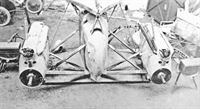 |
J.Herris - Gotha Aircraft of WWI /Centennial Perspective/ (6)
|
| Gotha GL forward fuselage at the USAS center at Romorantin, France postwar.
|
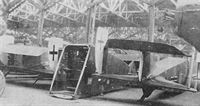 |
J.Herris - Gotha Aircraft of WWI /Centennial Perspective/ (6)
|
| Gotha GL fuselages at the USAS center at Romorantin postwar show the fuselage cross section.
|





























